The Silent Cries of Broken Dreams Ring Loud in UP's Maghar
Maghar (Uttar Pradesh): Maghar is the land of revolutionary saint Kabir Das, where he had found a retreat during the last days of his life. There is a mausoleum and tomb here dedicated to him. Kabir's Maghar belonged to the weavers, where the members of this caste weaved the finest cloth sheets.
Currently, the work of renovation and beautification of Kabir’s place of nirvana is ongoing in Maghar. While starting the campaign for the last Lok Sabha elections, Prime Minister Narendra Modi had laid the foundation of the Sant Kabir Academy here with a cost of Rs 24 crore; it is almost ready but has not been inaugurated yet. Besides this, many other projects have also been carried out under the Swadesh Darshan Scheme, but the Gandhi Ashram and spinning mill built in the city after independence have been closed for three decades. Nearly 2,500 labourers and employees of both the institutions were rendered jobless and were displaced, while more than 15,000 weavers dependent on the work lost their livelihoods. But their voice is not being heard even in the 2024 Lok Sabha elections.
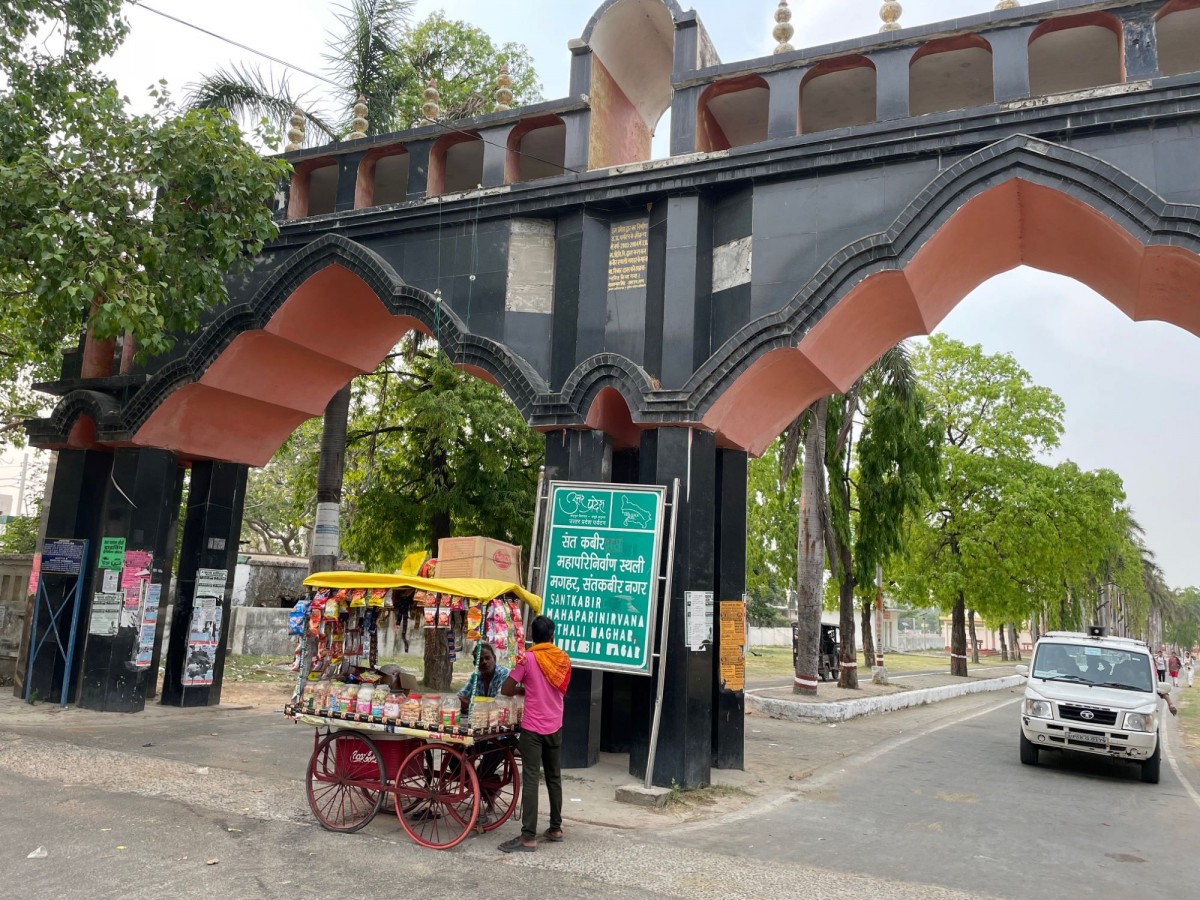
The Sant Kabir Nirvana sthal in Maghar. Photo: Manoj Singh
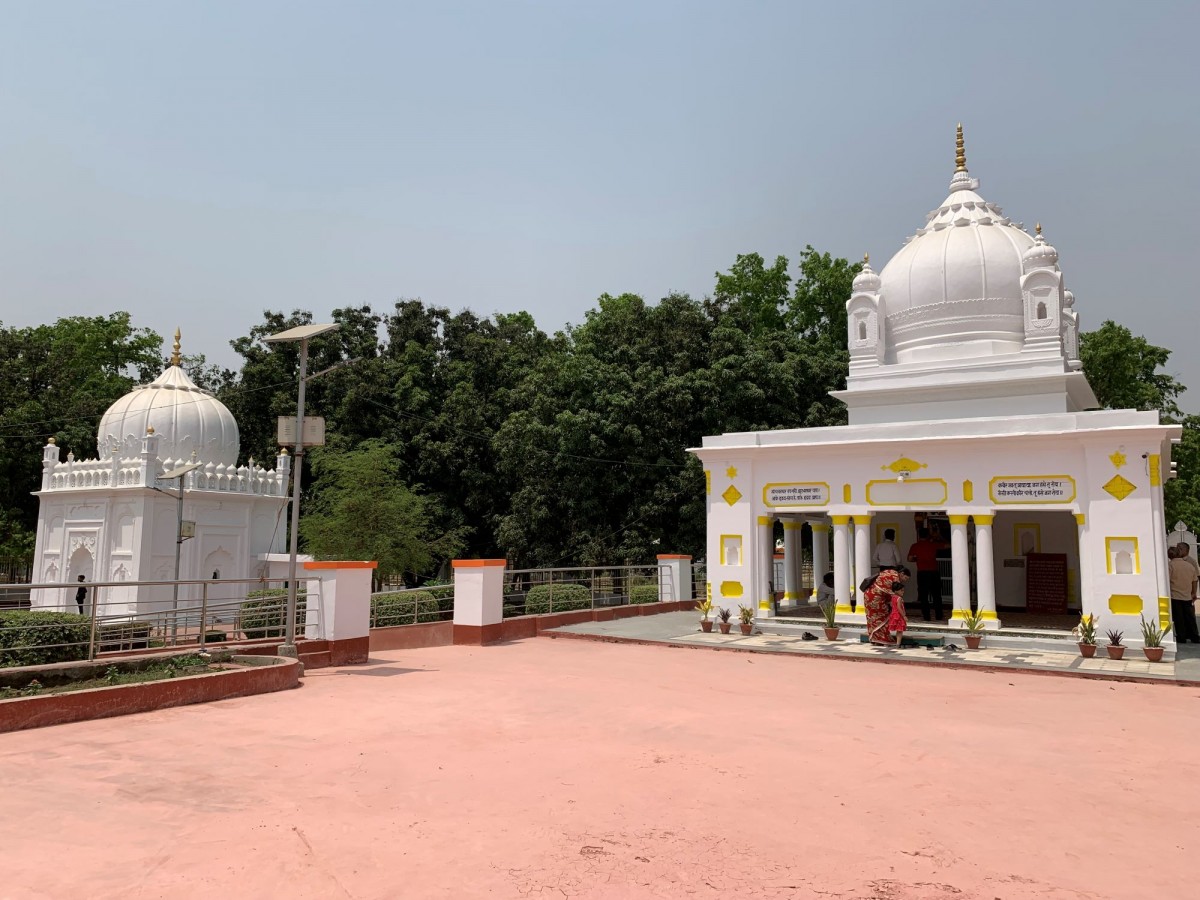
The mausoleum and tomb for Kabir. Photo: Manoj Singh
An ashram that was
Built in 1955, the Gandhi Ashram is right in front of Sant Kabir’s place of nirvana. It has remained closed since 1997. Around 1,000 workers and employees used to work here; only two dozen remain.
Jagai, who worked as a labourer in the Gandhi Ashram, retired on May 7. He used to transport clothes and other items made in the ashram. He had started working at the ashram in 1981. After working as a casual labourer for Rs 180 per month for about five years, he got a permanent appointment in 1986. His salary was fixed at Rs 210 per month. When he retired, his salary was Rs 10,500. The Gandhi Ashram still owes him his salary of five years in addition to gratuity, bonus, provident fund and other such dues.
Jagai is a resident of Gultahi Harpur of Sant Kabir Nagar district. Recalling his time spent at the Gandhi Ashram, he stated that items of daily use such as kurtas, pyjamas, soap, mustard oil, incense sticks, charkhas, chairs, tables and beds are made here. Weavers used to prepare bedsheets, clothes, towels and lungis using the yarn produced there. Two trucks were always at standby to deliver finished goods to sales centres, he said. The work of dyeing and printing clothes also went on day and night. The Gandhi Ashram had a grand generator which provided electricity to the entire complex.
"A thousand men worked there," he said. "More than 15,000 weavers and spinners were associated with the industry. Everyone was earning a decent livelihood. Everything is ruined now."
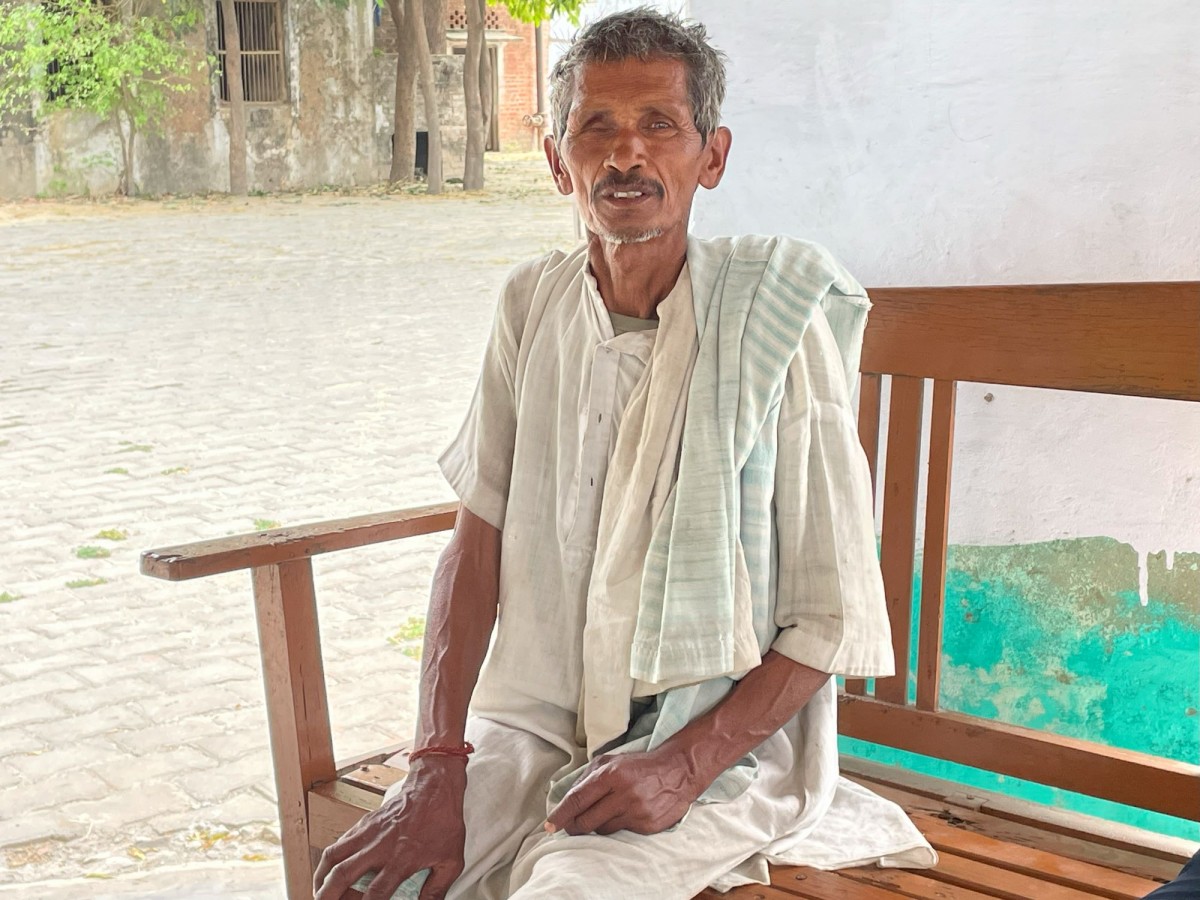
Jagai. Photo: Manoj Singh
Three other workers had retired on May 7 along with Jagai. Now, two permanent workers Ram Awadh and Ramvriksh Yadav are remain.
Ram Awadh is a cook at the Gandhi Ashram. There is a separate kitchen and a grand dining room for the workers on the premises. This hall has now become dilapidated and pigeons camp here.
The Gandhi Ashram is spread over 27 acres. It has a laboratory, an administrative building, a warehouse, a furniture manufacturing centre, a unit for manufacturing soap and incense sticks, a dyeing-printing unit and other centres. Except one or two buildings, all of them are in fine condition. However, due to neglect, weeds surround the entire premises. Monkeys roam free and posters of langurs have been put up at various places to scare them away.

Workers at the Gandhi Ashram. Photo: Manoj Singh
Gandhi Ashram's accountant Subhash Chandra Pandey has continued working as a daily-wage employee after retiring in 2021. While narrating the history of the ashram, Pandey, a resident of Sikandarpur, Ballia, said that it was established on July 2, 1955.
According to him, the ashram was autonomous in its functioning. "With the capital received from the Khadi Village Industries Commission, we operated it very well with our labour and skill. We used to get 25% rebate from the Central and state governments on the sale of the manufactured goods, through which we used to arrange the salaries of the workers and our expenses. Under this arrangement, the Gandhi Ashram ran smoothly from 1955 to 1997. Later we stopped getting help from the government and Khadi Village Industries Commission. This was the same time when the demand for goods produced by us also started decreasing in the market. Machine-made products entered the market. They were cheaper than the goods we produced. The government also stopped rebate on sales and introduced a system of rebate on production. As production was decreasing due to low demand, rebates also started reducing and Gandhi Ashram saw a financial crisis."
He said that workers and employees kept retiring and new recruitment was not carried out to replace them. When retired employees did not receive their PF, gratuity, bonus etc., many of them started filing cases in the courts. Today dozens of cases are pending in various courts. The workers and employees wanted the government to either help the Gandhi Ashram function or close it down and pay everyone's dues.

Subhash Chandra Pandey. Photo: Manoj Singh
Today, the Gandhi Ashram (Maghar) owes about Rs 22 crore towards workers' salaries, PF, gratuity as well as loans from some institutions. The government that claims to celebrate Gandhi and khadi is not ready to shoulder the burden of this liability.
At present, two dozen employees and officers are taking care of everything at the ashram. Most of them are working as daily-wage employees after retirement.
Ram Milan Chaurasia retired in 2018. He is also working as a daily wager. He is paid around Rs 8,000 per month. His family of ten members is barely getting by. "I am forced to work here in order to get my dues," he said. He is supposed to receive Rs 10 lakh from the Gandhi Ashram, he claimed. The ashram also owes Rs 10 lakh to store keeper Shivshankar Yadav who retired in 2022.
"To meet the expenses of salaries of its current employees, pay electricity bills, etc., many buildings of the Gandhi Ashram are being offered on rent to local businessmen. We are getting Rs 50,000 to Rs 60,000 per month from rent," he said.
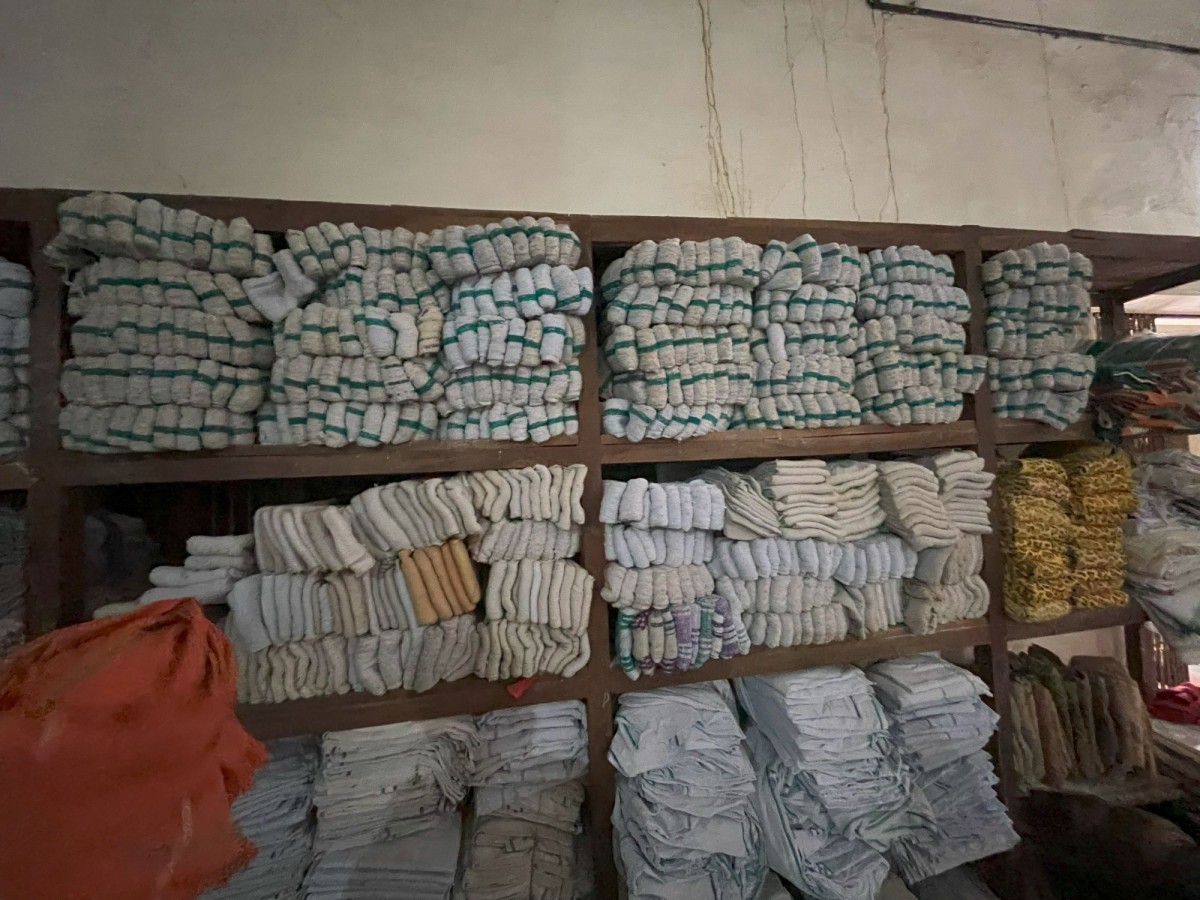
Clothes produced at the Gandhi Ashram. Photo: Manoj Singh
Gandhi Ashram regional secretary Ravindra Lal Srivastava will retire in July next year. He has also filed a case in the high court for his outstanding salary.
He said that the ashram has a lot of immovable property. Gandhi ashrams in Hansar, Chakia, Balushasan, Kauladih and others are connected to it and all of them also have immovable property. If the government takes a decision, Gandhi Ashram can regain its glory, he said.
Subhash Pandey, Shivshankar Yadav, Ram Milan Chaurasia, Jagai and Ram Awadh have no hope for the Gandhi Ashram functioning again. They claim that earlier leaders used to bring up the plight of the ashram in poll campaigns, but now no one raises the issue. "When the prime minister visited Maghar in 2018, we gave a memorandum to him through local MP Sharad Tripathi. Some hope had kindled but nothing has been done till now."
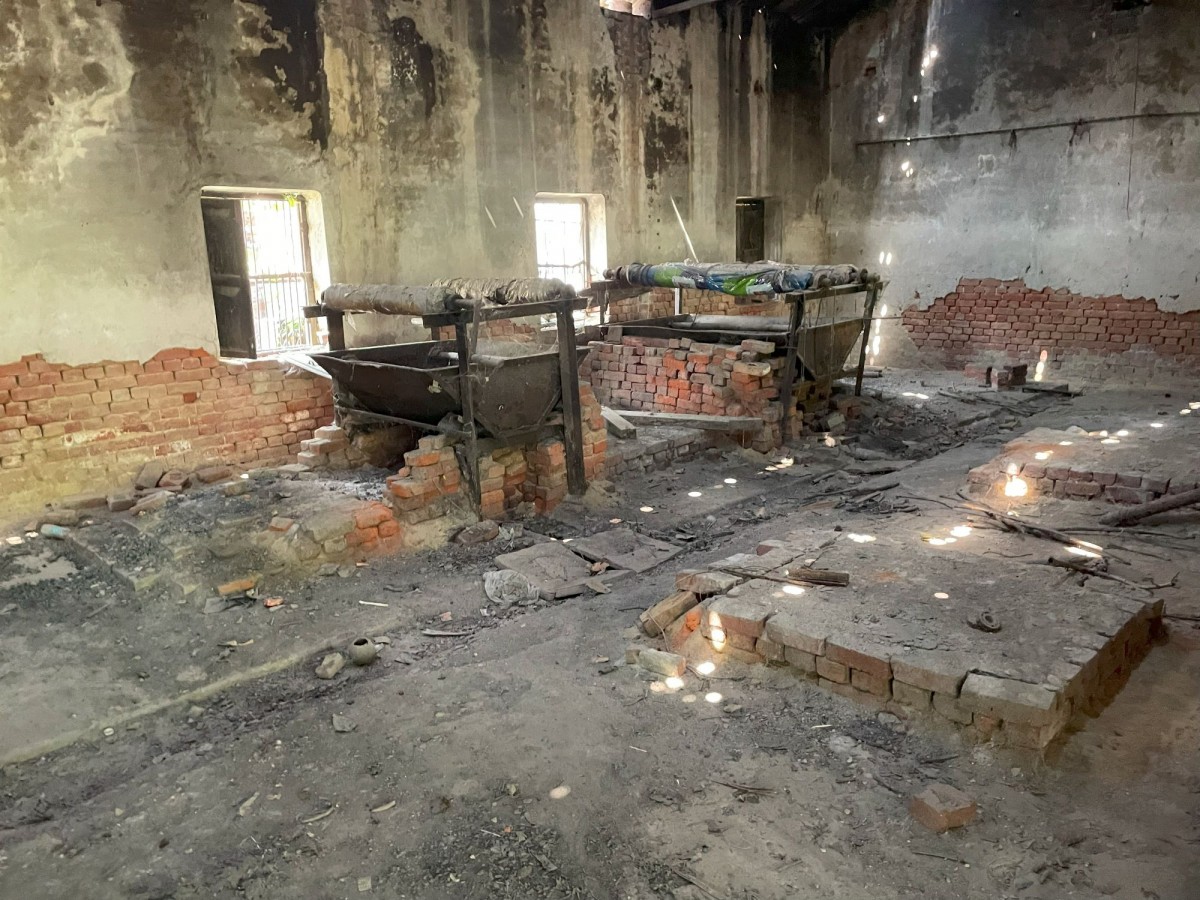
Machines at the Gandhi Ashram are no longer working. Photo: Manoj Singh
The people of Maghar town were also affected by the closure of Gandhi Ashram. Ramniwas Gupta's father had a thriving tea shop in front of the ashram. But when Gandhi Ashram was closed, the shop also closed with it. Ramniwas and his family migrated to Punjab to work as labourers. He returned four years ago and now sells chaat at the premises of Kabir Nirvana.
An abandoned mill
Like the Gandhi Ashram, the Sant Kabir Cooperative Spinning Mill, built in 1977 in the name of Sant Kabir, has been closed for 27 years. Production at the spinning mill had stopped in 1997. In 2007, all the employees were given VRS.
Though the spinning mill has been closed, the intersection near the mill is still known as Cotton Mill Square. Clothes brought from Surat are sold in shops here. These shops stand witness to the change in the economic condition of the place due to the closure of the cotton mill and the condition of the weavers.
A young man, Ashraf, has a shop named Ashraf Enterprises at this intersection. He sources track suit fabric from Surat, which the artisans stitch and sell in the local market. Ashraf's father was a handloom weaver. Like him, thousands of weavers used to weave gamchha, dhoti, kurta, lungi, and bedsheets on handlooms. People from Dalit community used to wash and dye the clothes prepared by the weavers on the banks of Aami near Kabir Ashram in Maghar. Sant Kabir Co-operative Spinning Mill produced yarn which was available to the weavers through moneylenders and corporations. This spinning mill made a huge contribution towards providing livelihood to the weavers.

The locked gates of the closed spinning mill is now a sticker board for ads. Photo: Manoj Singh
As a child, he had seen his father and grandfather work on the handloom at home, said 32-year-old Ashraf. Now, there is no handloom in any house in Maghar. The weavers either changed their jobs or migrated. Ashraf said that the weavers here are working in other places such as Bhiwandi in Mumbai. "Those who are still here have started other work. We in the third generation have also transformed from being weavers to traders," he said.
Kamal Ahmed of Maghar has been an employee in a spinning mill. He worked in the rolling department of a spinning mill where thread was manufactured. When asked about the present condition of the spinning mill, he recalled how it was inaugurated on January 9, 1977. "The state had a Congress government then and N.D. Tiwari was the chief minister. Sanjay Gandhi had been invited to inaugurate the mill. A special train was running to bring people here. Gandhi had reached the stage constructed inside the mill premises in an open jeep and delivered a speech," he said.
The platform still exists but the entire spinning mill complex has transformed into a jungle. Phoolman Yadav, who oversees the spinning mill, warns us not to enter the premises for fear of being attacked by wild boars or snakes. Except the employee colony and the outer road of the spinning mill complex, the entire complex is closed and no one is allowed inside. To take care of the spinning mill, 12 guards of a private security company are deployed who work in three shifts. They also warned us of the presence of wild boars and pythons throughout the campus, and added that theirs is a tough job. "If one is even a little careless, one can become a victim of snake bite or attack by pigs. During the rainy season the entire complex is inundated," one said.
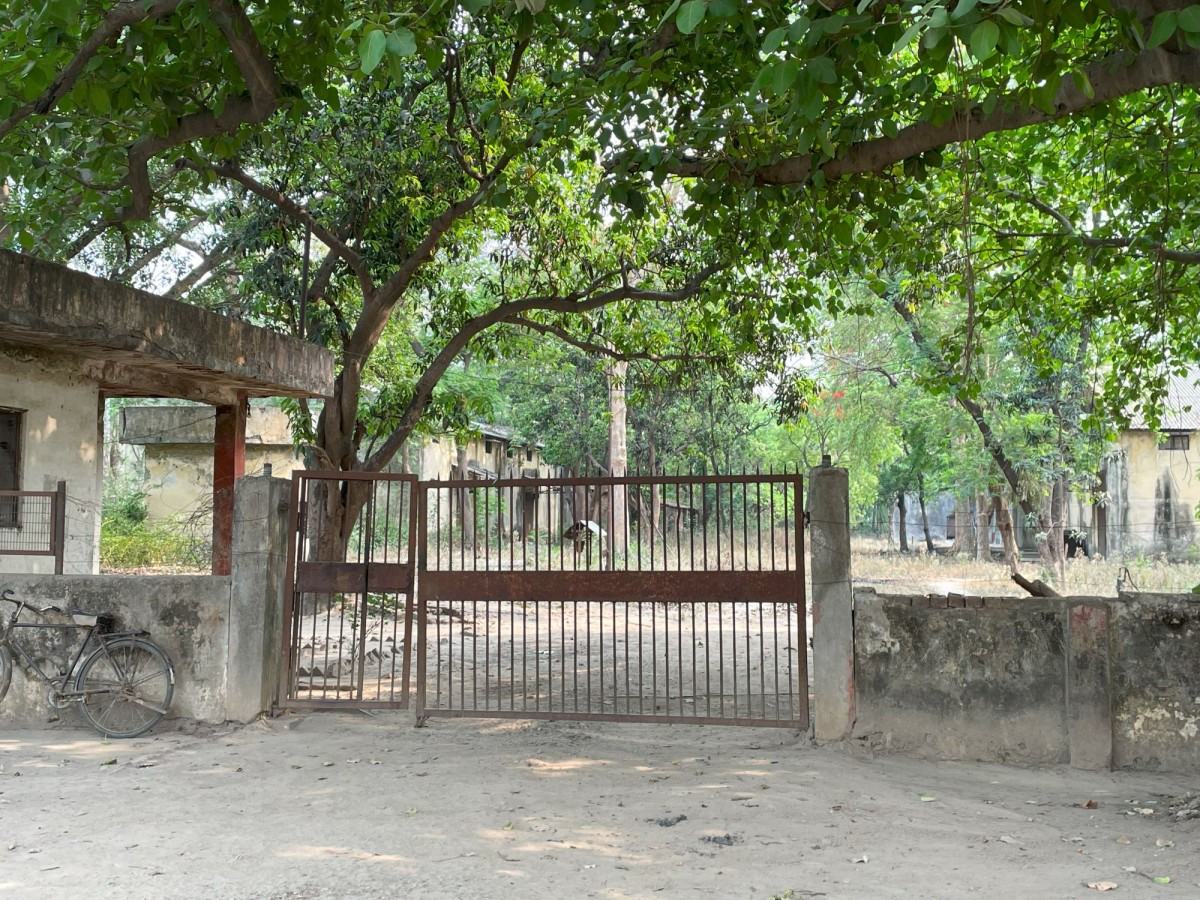
Gates of the spinning mill. Photo: Manoj Singh
Only two families are left in the employee colony now. The priest of the temple located in the spinning mill premises and Ram Singh, the driver of the first managing director and GM of the mill. Ram Singh is now old and crippled in one leg. He walks with the help of a stick. He has a wife, daughter and two sons. One of his sons is a driver while the other son is a factory worker in Gujarat. The mill owes him money too. He bought a piece of land in Maghar with the money received after VRS but could not build a house on it. The roof of his house leaks and the doors are crumbling.
He regrets his decision to leave Kanpur, where he used to work as a driver. IAS officer Hausila Prasad Verma, the first managing director of the spinning mill, had brought him here. He worked as a driver for the managing director and GM of the spinning mill until its closure.
Ram Singh blames the closure of the spinning mill on infighting among union leaders as well as looting by officers. He says that as long as the IAS officer served as a managing director, the spinning mill ran brilliantly. At one point, the mill was reaping a profit of Rs 9 crore. However, as soon as the post of managing director was abolished and replaced by the post of general manager, to which technocrats were appointed, bad days fell upon the spinning mill as money laundering and corruption increased.
Almost teary-eyed, Ram Singh recalls the day of closure of the spinning mill. After the closure of the spinning mill, he faced a lot of tribulations. His son had to undergo a surgery due to a kidney ailment. His leg was fractured. "Today, I am helpless and forced to live alongside snakes and millipedes," he said. "If I had my own home, why would I live in this deserted place?"
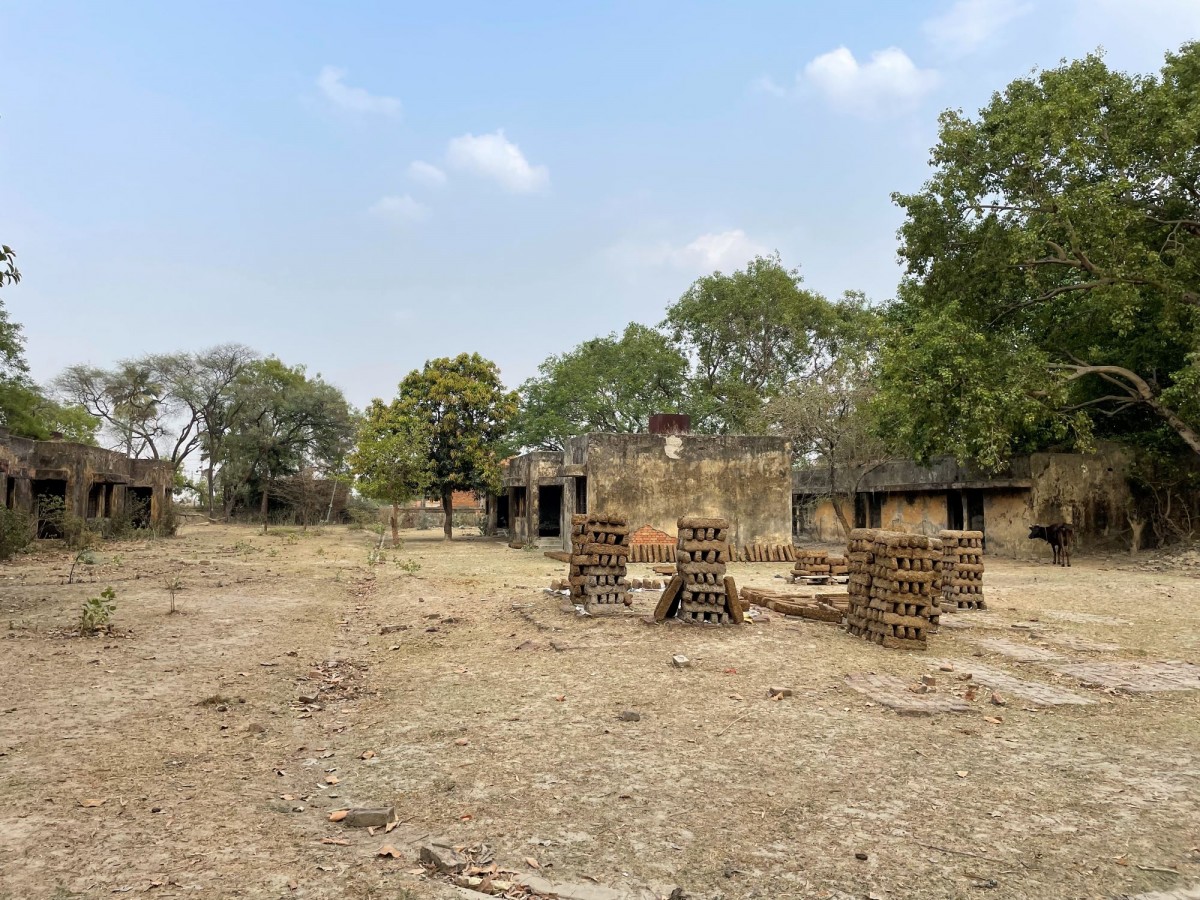
The spinning mill compound. Photo: Manoj Singh
The spinning mill had 1,450 labourers and employees who had mostly come from Deoria, Gorakhpur and Bihar. At the time of establishment, most of the labourers and employees hailed from other districts but later 450 workers from Maghar were also recruited. There were many fights between two groups of workers regarding this. Kamal Ahmed was appointed here at the same time. When the spinning mill closed in 1997, he used to get a salary of Rs 4,500. He worked as an apprentice for 11 months at Rs 2,500 per month. A union was formed under the leadership of Bhalchandra Yadav, who was the MP of Sant Kabir Nagar, which had launched a successful movement to increase the wages of workers and employees.
The UP State Handloom Corporation and some traders used to buy the yarn from the spinning mills. Due to various reasons, the spinning mills of Uttar Pradesh were closed one by one and the UP State Handloom Corporation was also closed.
Maghar's spinning mill was a unit of the UP Cooperative Spinning Mills Federation. The federation had a total of 11 mills. All of these have been closed for more than two decades. The mills of UP State Spinning Company Limited, UP State Textiles Corporation Limited, UP State Yarn Company Limited are also closed. In 2016, the Akhilesh Yadav government had promised to get these mills running again. The Yogi Adityanath government is now preparing to hand over the mill land to the Uttar Pradesh State Industrial Development Authority so that new industries can be set up here. The government has said that these mills have a liability of Rs 3,000 crore of which the state government will give up its liability of Rs 500 crore. These mills have more than a thousand acres of land which will be used to set up new industries.
Even after VRS was given to the workers of the spinning mill, the people of Maghar had not given up hope of restarting the spinning mill. Ashraf formed the Sant Kabir Cooperative Spinning Mill Sangharsh Committee six years ago and tried to clear the dues of the workers and restart the mill. According to Ashraf, he gave memorandums to officers and leaders from Maghar to Lucknow but in vain. When Modi came to lay the foundation stone of Sant Kabir Academy in Maghar, he gave a memorandum to him through the Nagar Panchayat president. But now, he has lost all hope.
"Now this mill will not work," said a dejected Ram Singh. "This government could not run it, no other government will be able to run it either. Now we do not want to stay here even for a minute but we are helpless."
Modi came to Maghar on June 28, 2018 to lay the foundation stone of Sant Kabir Academy and addressed the gathering. He said that by spending about Rs 24 crore, institutions will be built here to preserve the memories related to Kabir. There is a plan to develop a music training centre, dance training centre, research centre, library, auditorium, hostel and art gallery, which showcase Kabir's work.
The Sant Kabir Academy was proposed to be built and launched by June 14, 2022, but is still not completely ready.
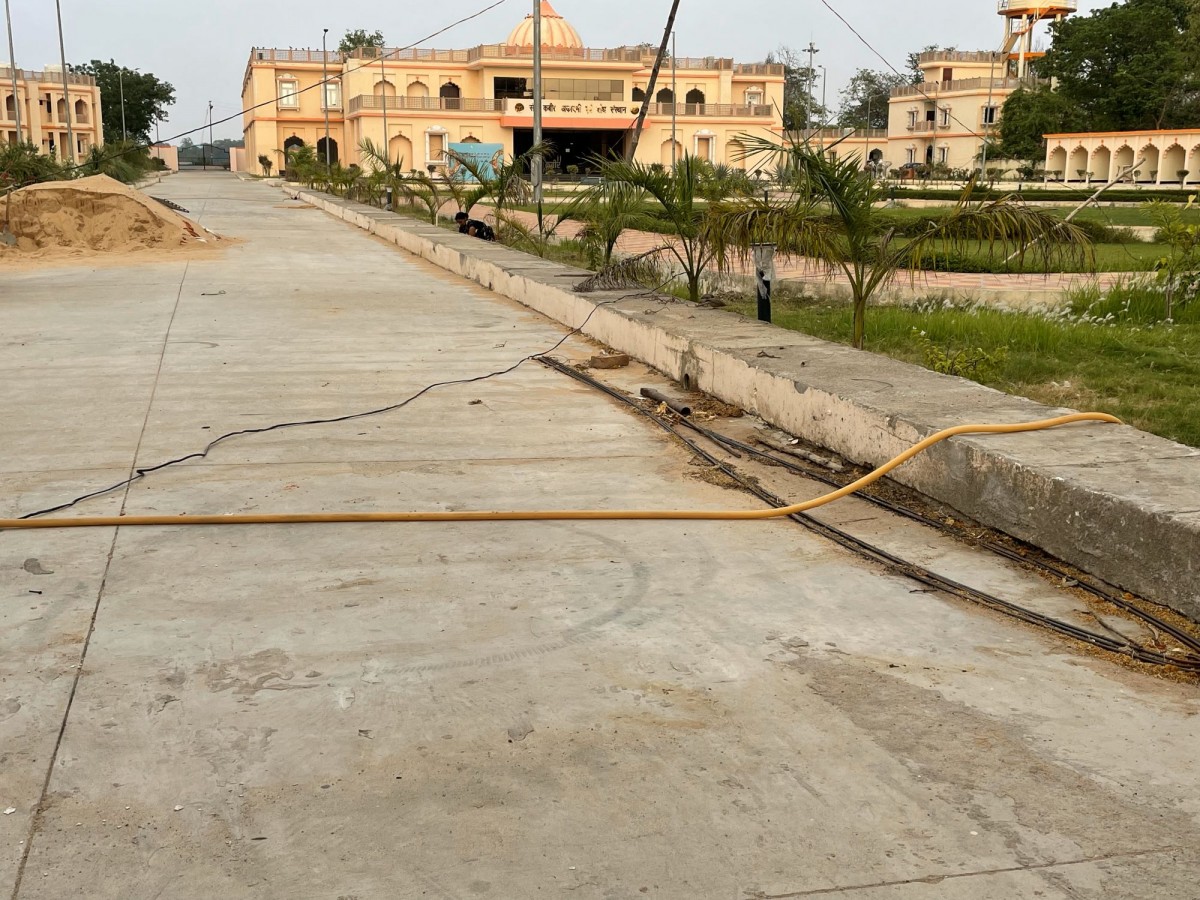
The Sant Kabir Academy. Photo: Manoj Singh
On one hand, an academy is being established at a cost of Rs 24 crore to preserve the memories and thoughts of Saint Kabir. On the other hand, the dream of turning the ideas of Kabir and Gandhi into a ground reality has been shattered by the closure of the Gandhi Ashram and spinning mills. There is silence in Maghar which was once alive with the sound of charkha making and cloth weaving. The silent cries of dejected workers like Ram Singh and Jagai are falling on deaf ears.
Translated from the Hindi original by Naushin Rehman.
This article went live on May twentieth, two thousand twenty four, at forty-eight minutes past two in the afternoon.The Wire is now on WhatsApp. Follow our channel for sharp analysis and opinions on the latest developments.




